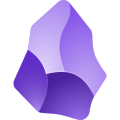Obsidian is a personal knowledge base and note-taking software application that operates on Markdown files.[3][4] It allows users to make internal links for notes and then to visualize the connections as a graph.[5][6] It is designed to help users organize and structure their thoughts and knowledge in a flexible, non-linear way. The software is free for personal use, with commercial licenses available for pay.[3][7]
 | |
 Obsidian open with a chemistry note, graph view, and calendar | |
| Original author(s) |
|
|---|---|
| Developer(s) | Dynalist Inc.[1] |
| Initial release | March 30, 2020 |
| Stable release | 1.6.5 / June 25, 2024 |
| Written in | Electron, JavaScript, HTML, CSS |
| Platform | Windows, macOS, Android, Linux, iOS |
| Type | |
| License | Freemium[2] |
| Website | obsidian |
History
Obsidian was founded by Shida Li and Erica Xu while quarantining during the COVID-19 pandemic.[8] Li and Xu, who had met while studying at the University of Waterloo, had already collaborated on several development projects.[9] Obsidian was initially released on 30 March 2020.[10] Version 1.0.0 was released in October 2022.[11][12] Version 1.1, which added the Canvas core plugin, released in December 2022.[13] In February 2023, Steph Ango joined Obsidian as CEO.[14]
Features
Obsidian is built on Electron.[7] It is a cross-platform application that runs on Windows, Linux, and macOS, as well as mobile operating systems such as Android and iOS.[7] There is no web-based version of the software.[9] Obsidian on all platforms can be customized by adding plugins and themes, which enable users to extend the software's functionality with additional features or integration with other tools.[7] Obsidian differentiates between core plugins, which are released and maintained by the Obsidian team, and community plugins, which are open-sourced through GitHub and are contributed by users.[15] Examples of community plugins include a Kanban-style task board and a calendar widget.[4] There are over 200 community made themes to use with the app.
Obsidian operates on a folder of text documents; each new note in Obsidian generates a new text document, and all the documents can be searched from within the app.[7][4] Obsidian allows internal linking between notes and creates an interactive graph that visualizes the relationships between notes.[7][9][4] Text formatting in Obsidian is achieved through Markdown, but Obsidian provides the instantaneous previewing of formatted text.[7]
An Internet forum and Discord channel are hosted by the developers.[9]
See also
- Comparison of note-taking software – Comparison of computer software designed for taking notes
- Comparison of wiki software – Software to run a collaborative wiki compared
- Personal wiki – Wiki for a single user